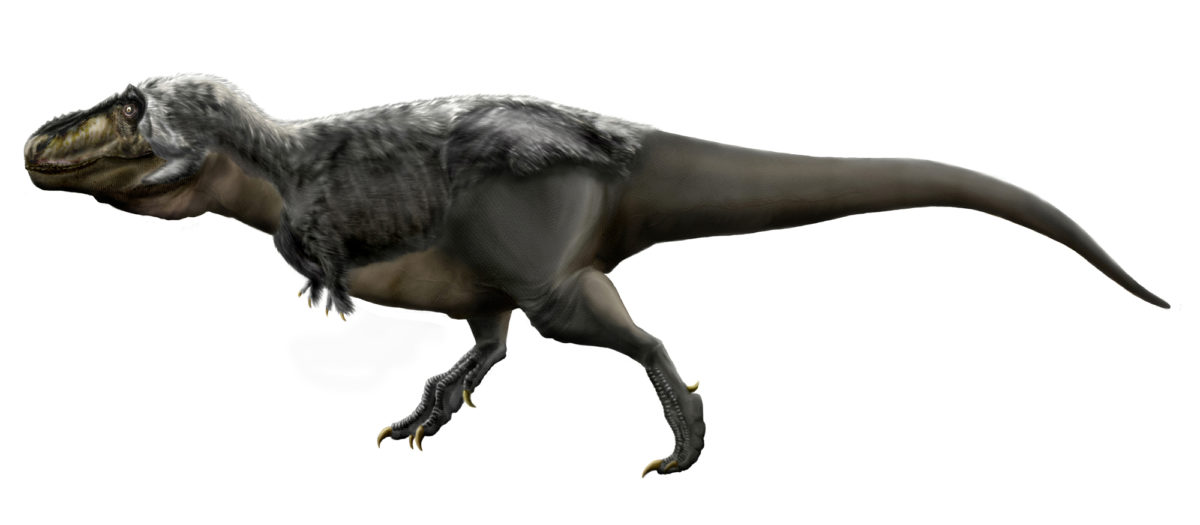Chapter contents:
Paleoecology
– 1. Paleoenvironmental Reconstruction
– 2. Biogeochemical Analysis and Paleoecology
– 3. Predation in Paleoecology
–– 3.1 Insect Herbivory in the Fossil Record
–– 3.2 Drilling Predation in the Fossil Record
–– 3.3 Dinosaur Predation in the Fossil Record ←
Overview
When it comes to predators in the fossil record, Tyrannosaurs, Allosaurs, and their dinosaur kin rank at the top of the list. During the reign of the theropods—predatory dinosaurs, and the group from which modern birds evolved—essentially all other animals were on the menu, including fish, mammals, lizards, pterosaurs, and other dinosaurs of all shapes and sizes. Although theropods came in a range of sizes, including the chicken-sized Velociraptor, it has been the discoveries of large carnivorous dinosaurs like Tyrannosaurus rex (in the early 1900s) that have captured the minds and imaginations of the world. Known for its crushing jaws and tiny arms, T. rex has become one of the best-known extinct organisms of all time, particularly following Arthur Conan Doyle’s “The Lost World” and Michael Crichton's "Jurassic Park" books and corresponding movies. New technologies and fossil discoveries continue to reshape what we know about the paleoecology of this impressive dinosaur and its fellow Mesozoic predators.
"Tyrannosaurus Rex / Triceratops [SmithsonianDPO]" created by the Smithsonian’s Digitization Program Office (Creative Commons Attribution-NonCommercial 4.0 International license).
How do we know what dinosaurs ate?
Without the ability to watch dinosaurs interact, paleontologists must turn to other sources of information to determine what different dinosaurs were eating. Body size is a good first estimate, as observations of modern communities show that big individuals tend to eat small individuals. Simple as it may be, looking at body size can be a good first step to understand the trophic structure of a community. Other pieces of evidence like bite marks, injuries from interactions, and fossilized excrement can help fill in more of the specifics about exactly who was eating who.
Bite marks
During the process of consuming a fresh kill or scavenging the remains of a carcass, dinosaurs occasionally left bite marks on the bones of their meals. Based on the shape and size of the bite marks, which are a type of trace fossil, the maker of those marks can be determined. This is because, in any given dinosaur community, there were often only a small number of predators of a particular size. For comparison, think of a forest or savannah today; how many large predators can you think of for a given habitat? Though not always perfect, matching bite marks to the teeth in the mouths of predators from the community can help determine how interactions unfolded in the past.
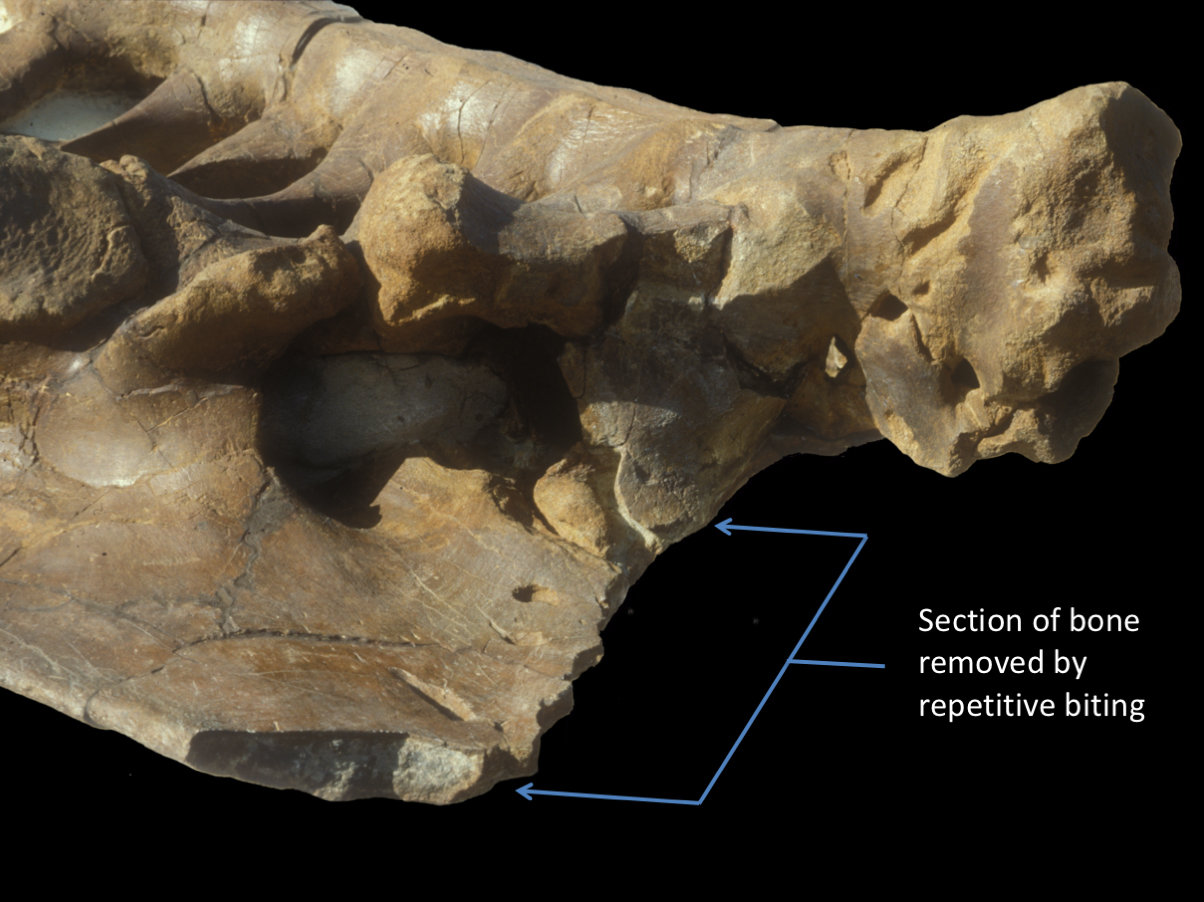
"Left ilium of Triceratops sp. (MOR 799) in ventrolateral view with ~80 bite marks attributed to Tyrannosaurus rex. A large portion (~17%) of the iliac crest was removed (bracketed) by repetitive, localized biting." Figure and caption from Gignac and Erickson (2017) in Scientific Reports; Creative Commons Attribution 4.0 International license.
In some cases, the bite marks on fossil bones can be matched to the very same species. That is, there is evidence that cannibalism occurred. Examining the bones of dinosaurs in the collections of several collections, a team of researchers led by Nicholas Longrich found seventeen specimens with tooth marks made by T. rex. Several of the bitten bones belonged to hadrosaurs and ceratopsians; however, four of the seventeen bitten bones belonged to T. rex, indicating cannibalism. Although there is some uncertainty in identifying predators based on their bite, the researchers were aided in this case by the absence of any other large predators from this time (Late Maastrichtian) in the Western Interior of North America. The only plausible predator was T. rex. In discussing the implications of this find, the researchers note that the T. rex were not likely killed in acts of predation by other T. rex. Instead, they suggest the T. rex were likely fed upon by an opportunistic conspecific (a member of the same species) encountering an already-dead T. rex because many other prey options were available and attacking another T. rex would have been very risky. You can take a closer look at the cannibalized T. rex bones in the image below.
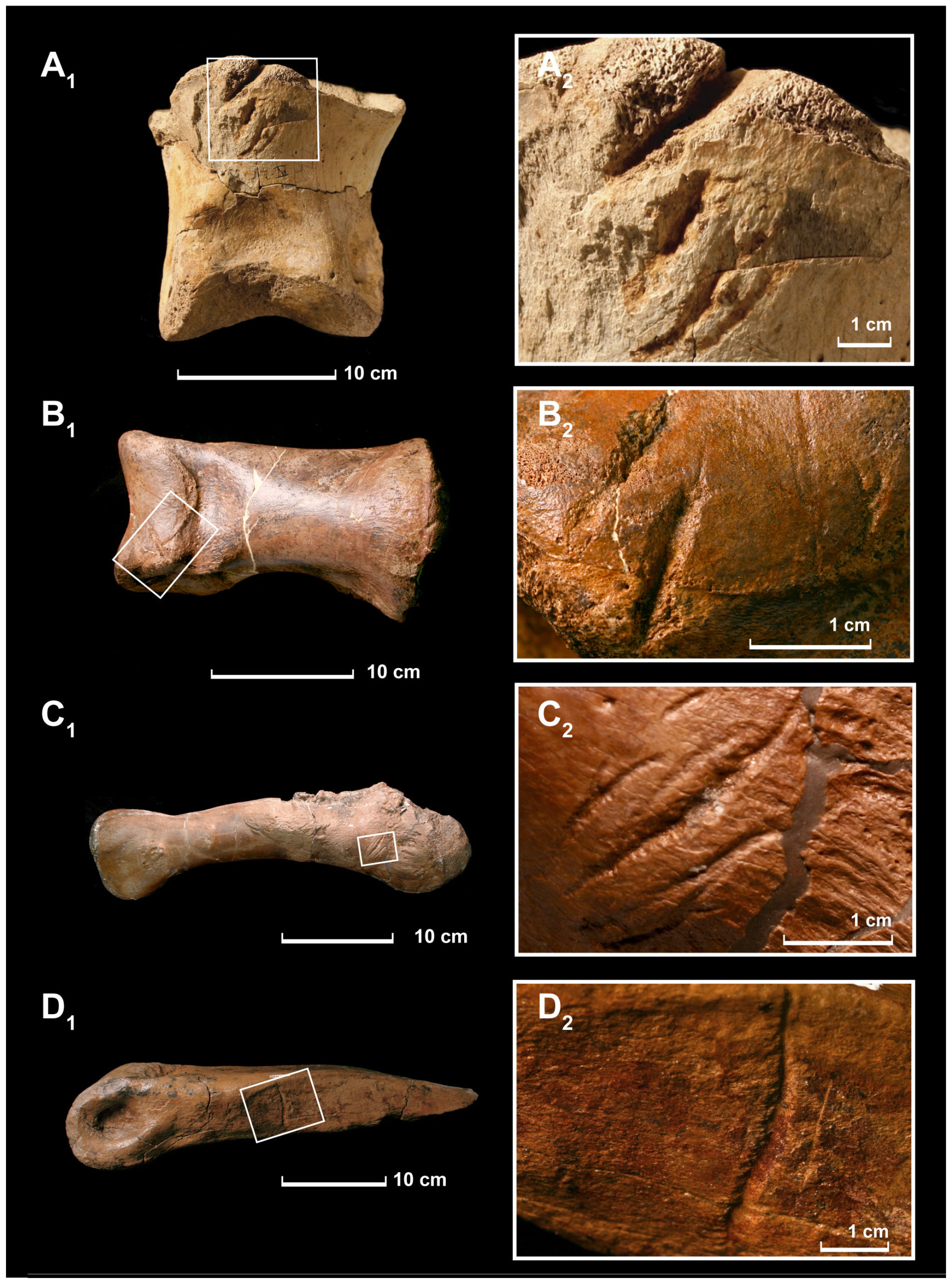
Evidence of injuries
Predators “win” many of the encounters they have with their prey but, in some interactions, prey do get the better of their predators. Usually, a “win” for the prey simply means surviving the encounter and living to see another day, even if they do suffer a few injuries. For example, Richard Butler and his colleagues found evidence that a sauropod (or, long-necked dinosaur) found in South Africa survived the loss of a large portion of its tail. In extreme cases, a win for the prey can result in death for the predator (and not through starvation).
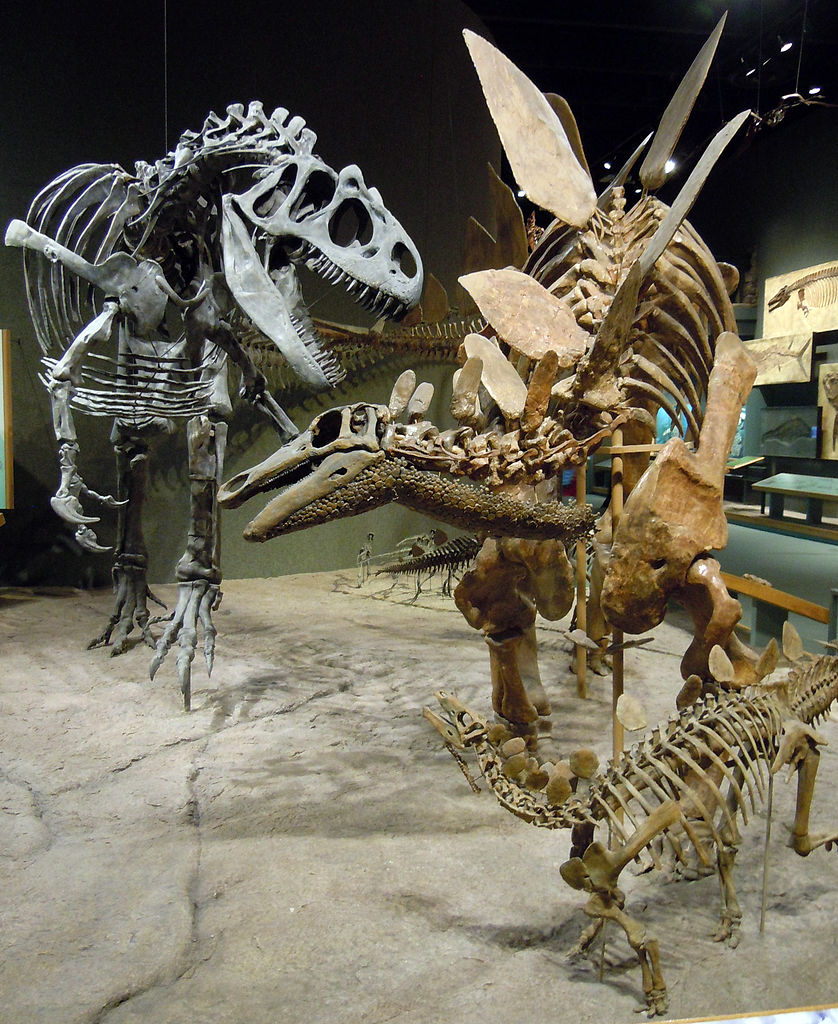
A reconstruction of an Allosaurus attacking two Stegosaurus from the Denver Museum of Nature and Science. Image by mrwynd; Creative Commons Attribution 2.0 Generic license.
Many dinosaur species like Triceratops, Ankylosaurus, and Stegosaurus protected themselves from their predators with defensive horns, plates, spikes, and clubs. These defenses were formidable and occasionally deadly. In several reports, individuals of the large predator Allosaurus—a theropod dinosaur, like T. rex, that lived 155–145 million years ago—have been found with puncture wounds from encounters with Stegosaurus. Robert Bakker and his colleagues reported an Allosaurus specimen with multiple large wounds through its pelvis, roughly the size of the tail spikes carried by stegosaurs—known popularly as thagomizers. This Allosaurus was so severely injured that it did not recover and eventually died of its wounds. Evidence from other individuals suggests that these two Jurassic giants likely clashed on a regular basis. As with the bite marks, these trace fossils show evidence of behaviors in the fossil record. Here, those behaviors include predatory attack by the Allosaurus and self-defense by the Stegosaurus.
Coprolites
Coprolites, which are fossilized excrement, provide a wealth of information to paleontologists about what extinct animals were eating. Though it is not always possible to link a specific coprolite to a certain species, recurring associations between coprolites of a given shape and size, along with dinosaurs of the same age that could plausibly produce the coprolite, help narrow the possibilities. At the least, coprolites give insights to the trophic structure of the community by revealing the presence of predators and, by identifying the remains in the coprolite to a species, can tell us who was being eaten. Watch the video below to learn more about coprolites.
"Discovering the Past Through Dino Poop" by SciFri. Source: YouTube.
Unlike body fossils, trace fossils like coprolites give an indication of the behavior of long-dead animals. This added perspective helps paleontologists interpret how individuals in past communities interacted with each other and provides unique insight into the ability of dinosaurs to digest their food. Like many other types of fossils, the original organic content in coprolites has typically been replaced by minerals composed of calcium carbonate and silica.
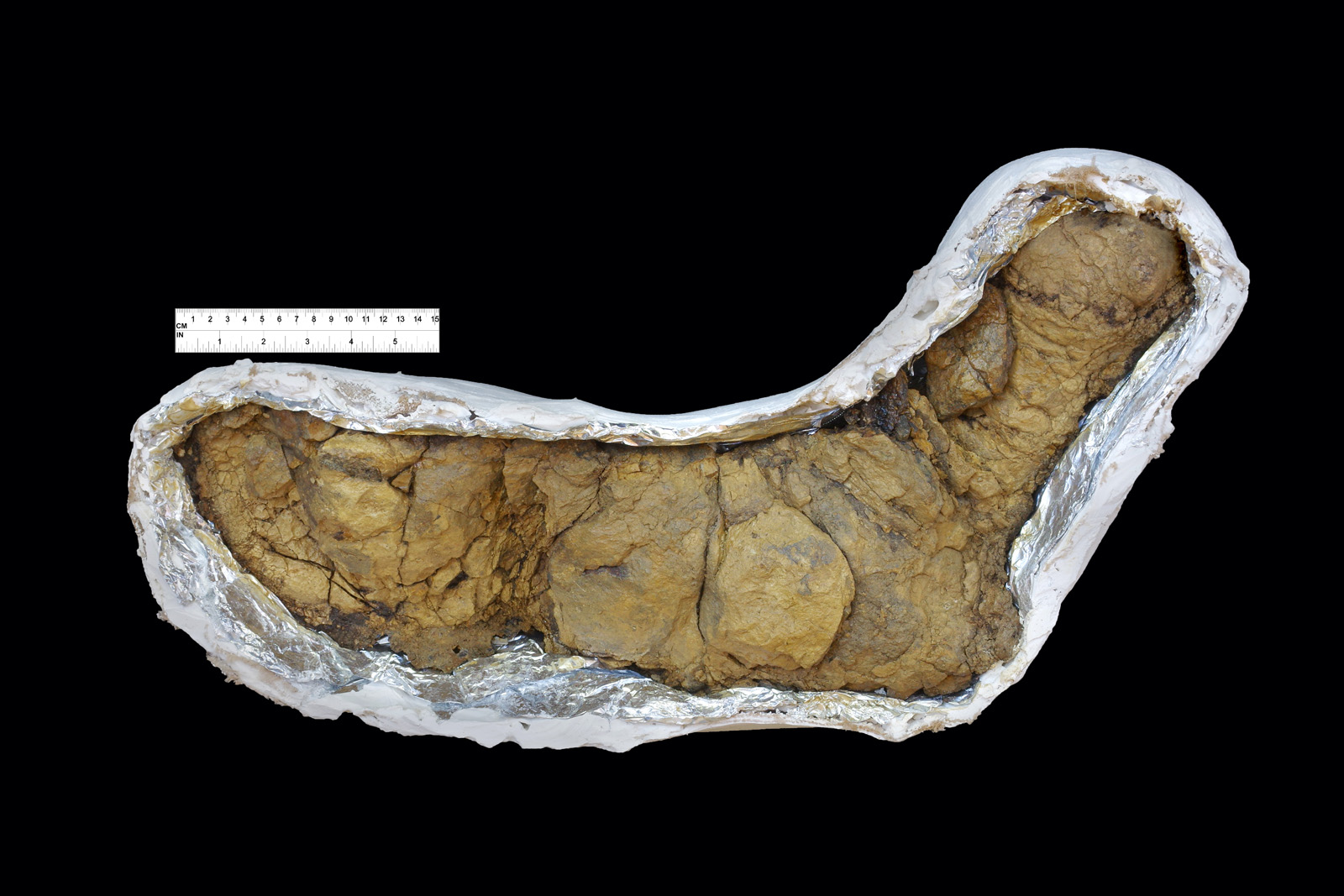
"Fossil feces from a carnivorous dinosaur - most likely a Tyrannosaurus rex. Discovered in Harding County, South Dakota, USA. This coprolite is 63.5 cm long by 15.25 cm wide (25 inches long by 6 inches long). Scale bar is 15 cm (approximately 6 inches) long. A X-ray fluorescence analysis of this specimen showed the presence of phosphorous and calcium in significant amounts. This coprolite also contains a high percentage of crushed bone inclusions. It is nicknamed “Barnum” after Paleontologist, Barnum Brown, who discovered the first Tyrannosaurs rex." Image and caption by Poozeum; Creative Commons Attribution-Share Alike 4.0 International license.

Phytolith examples from modern elephant grass viewed with a scanning electron microscope. Left, central, and right images by Benjamin Gadet; Creative Commons Attribution-Share Alike 3.0 Unported licenses.
Coprolites produced by herbivorous dinosaurs can be used to understand the evolution of the plant groups they were eating. Studies on coprolites from herbivores often focus on phytoliths, which are microscopic hard parts produced by some groups of plants. Like using morphology to identify other types of fossils, the shape and size of a phytolith is specific to certain plants. For example, the phytoliths in the image above all belong to elephant grass. Examining the phytoliths in coprolites of sauropods from Pisdura (India), a team of scientists led by Vandana Prasad found abundant silica rich phytoliths in the late Cretaceous (65–70 million years ago) fossils. This discovery suggests that grasses evolved to have a high silica content—as a defense against herbivory—earlier in evolutionary history than previously thought. More recently, a team of researchers led by Yan Wu found grass phytoliths in a coprolite from a duck-billed dinosaur (i.e., a hadrosaur) in China dating from between 113 and 101 million years ago. This represents the oldest known grass fossil and confirms that this important group, which today includes plants like corn, wheat, and rice, had already diversified at least 101 million years ago.
A closer look at Tyrannosaurus rex
Tyrannosaurus rex, or T. rex, is among the most famous ancient creatures to have ever walked the earth. With its massive size and huge jaws, it has been the inspiration for numerous books and movies, capturing the imagination of movie- and museum-goers alike for more than a century. Pop culture aside, the history of study of T. rex has been equally intriguing, as new discoveries continue to change our interpretations of this dinosaur. Among those changes, T. rex has gone from a slow, lumbering scavenger to an agile predator; a solitary pursuit predator to a social hunter like lions on today’s savannah; and, many reconstructions now show T. rex covered in feathers like modern birds rather than crocodile-like scales. With each new discovery, we get a little closer to understanding this enigmatic predator. Watch the video below for more on the history of T. rex in pop culture and science.
"T. rex: The King of Time (and Pop Culture)" by American Museum of Natural History. Source: YouTube.
Tyrannosaurus rex: Hunter or Scavenger?
Despite its reputation as a fearsome predator, it has been proposed on several occassions that T. rex was instead a scavenger; however, the idea that T. rex relied on already-dead food has been thoroughly rebuffed. In the 1990s, dinosaur paleontologist Jack Horner caused a stir in the scientific community by suggesting that T. rex was too slow and clumsy to be an active predator, as it is typically considered. Horner himself has since backtracked, taking the stance now that T. rex was both a predator and scavenger. In all likelihood, this is the correct conclusion. As mounting evidence suggests (see the videos below), T. rex was a capable predator but it probably would have taken advantage of an easy meal like another freshly-dead dinosaur.
"T-Rex: Predator or scavenger?" by BBC Studios. Source: YouTube.
When examining the skeletons of dinosaurs living at the same time as T. rex, there are more and more cases where T. rex bite marks are being found. These did not always result in the death of the animal, as many of the fossil specimens show regrowth of bone at the site of the wound. In addition to bite marks, T. rex teeth have also been found embedded in the bones of their prey. Finding teeth actually in the bone removes all doubt about which predator was responsible for inflicting the injury: T. rex was the culprit.
"Broken-Off Tooth May Prove the T. Rex Was a Hunting Predator?" by Slate. Source: YouTube.
Additional evidence of aggressive behavior from juvenile T. rex further reaffirms the predatory nature of this species. Examining the skull of an 11-year-old juvenile T. rex named Jane, a team of scientists led by Joseph Peterson found four distinct punctures in the jaw and snout of the specimen. Severe though it may have been, the bite from these wounds did not result in Jane’s death. Instead, the wounds healed over, resulting in a slight abnormality in the appearance of the animal’s nose. Despite being a juvenile, this young dinosaur likely still weighed 1,500 pounds, stood seven and a half feet tall, and measured twenty-two feet from nose to tail. Very few animals would have been capable of inflicting a bite wound like the one found on Jane. As discussed by Peterson and his collaborators, the bite most likely came from another juvenile T. rex. The punctures on Jane’s skull bear a striking similarity to the set of teeth in her own mouth, suggesting a T. rex of similar size inflicted the wound. Turning to modern organisms for comparison, the scientists note that such behavior between juveniles is common in animals like crocodiles. Through comparison, they concluded that Jane’s wound may have resulted from a territorial dispute or struggle for dominance between the two young tyrannosaurs. Though this interaction was not likely one of predation, the end result suggests a strong, agile dinosaur capable of inflicting damage on other large dinosaurs.
In this animation, "Jane the tyrannosaur - from a pile of bones to an active predator" by WitmerLab, notice the multiple puncture wounds behind the nostril. Source: YouTube.
Tyrannosaurus rex body posture
In recreations of T. rex, the posture of its body has changed considerably since the first specimen was discovered in 1902 by Barnum Brown of the American Museum of Natural History. This shift in posture has coincided with changes in how we think T. rex behaved, namely that it is now considered an active, agile predator instead of a lumbering, clumsy scavenger. Originally, the sheer size of a T. rex—up to forty feet long, 12 feet high, and 15,500 pounds—led Brown and his contemporaries to mount the first specimen in what has become known as the “tail-dragging” posture. With this posture, the T. rex appears to have used its large tail to prop itself up against the ground. Although it was recognized early on that this posture was not particularly life-like, the first T. rex went on public display in the tail-dragging posture because, at the time, it was the only way the skeleton could be supported. Nonetheless, this image of the T. rex persisted for much of the century that followed, contributing to the idea that the T. rex was a slow, lumbering giant.

The two Tyrannosaurus rex shown here represent the original (left) and modern (right) reconstructions of its posture. Note, the modern reconstruction also includes feathers. Left image by William Matthews; Wikimedia Commons (public domain). Right image by Durbed; Creative Commons Attribution-Share Alike 3.0 Unported license.
Reconstructions of T. rex running speeds further suggest that this predator did not drag its tail. Running speeds can be calculated based on the spacing of footprints and the size of the dinosaur, both of which are pieces of information we can attain for T. rex. The equation for calculating these running speeds has been developed in other theropod dinosaurs (relatives of T. rex) and can similarly be applied to this species. Based on their trackways, McCrea et al. report that their T. rex were likely moving at a pace of approximately 8.5 kilometers per hour, or just over 5 miles per hour. The T. rex responsible for making these tracks were likely walking at a speed similar to an average human walking pace.
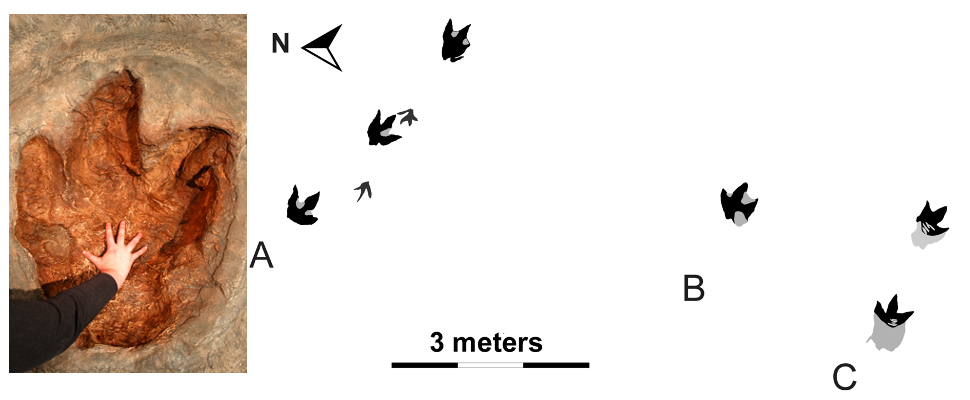
The footprint of a T. rex (left) with a human hand for comparison and a schematic of T. rex trackway from British Columbia, Canada (right). Left image by Chris Kirkman; Creative Commons Attribution 2.0 Generic license. Right image caption: "A portion of the tracksite showing three parallel trackways of Bellatoripes fredlundi and a partial trackway of a smaller theropod Saurexallopus cordata. Trackway A: PRPRC 2011.11.001; Trackway B: PRPRC 2012.04.002; Trackway C: PRPRC 2012.04.003. This trackway map was produced by tracings taken from the site, but outlines of the prints were produced by studying the silicone moulds of all the trackways at the Peace Region Palaeontology Research Centre (PRPRC). Trackway B has two tracks (only the first one is figured, the second is a pace length in front), but a debris slide covered the second print shortly after discovery at the end of the field season." Caption and figure from McCrea et al. (2014) in PLoS ONE; Creative Commons Attribution 4.0 International license.
Running speeds for T. rex have been calculated based on their potential muscle mass in combination with comparisons to living organisms like alligators and chickens—some of the closest living relatives to T. rex. These reconstructions are somewhat more speculative than those from trackways because they are based on the assumption that living species are reasonable models for T. rex movement, whereas the trackways record the actual behavior of the T. rex. Still, the estimates provide an approximation for the speeds that might have been possible for a T. rex.
Through these comparisons and putting some constraints on how muscular the T. rex may have been, scientists John Hutchinson and Mariano Garcia reported that T. rex could likely only run at speeds up to 25 miles per hour. In order to run at this speed, Hutchinson and Garcia suggest the T. rex would have been at maximum muscular exertion and thus would not often have reached this speed. For comparison, the fastest human speeds, by Olympian Usain Bolt, are approximately 28 miles per hour. Compared to animals living today, the T. rex is not all that fast, as animals like horses, deer, and cheetahs can more than double the T. rex speed. This comparison is, however, misleading. The biggest constraint on T. rex speed was the amount of muscle needed to move such a large body, according to Hutchinson and Garcia. Given that the dinosaurs T. rex preyed upon were also very large, it is doubtful that the prey species would have been able to run any faster. So, even though a human could probably outrun a T. rex, most large dinosaurs from the Cretaceous would not have been able to accomplish this feat. For the T. rex, even these speeds would not have been possible it were dragging its tail. The extra effort to pull its tail along the groung would require significantly more muscle mass, which was ruled out by Hutchinson and Garcia.
Though many things about T. rex were large and intimidating, its arms were not among those. Compared to the rest of its body, T. rex had very small arms, at least as adults. In fact, the arms are so small that they are similar in length to those of an adult human. The discovery and confirmation of juvenile T. rex has helped improve our understanding. Originally, several juvenile T. rex were incorrectly classified as other species, like Nanotyrannus, because the proportions of the smaller (juvenile) and larger (adult) tyrannosaurs differed from each other. Additional study has shown that the smaller individuals, which had been thought to be full grown adults of other species, were still growing quickly. This quick growth rate, as evidenced by analysis of the rate of change in the animals’ bones, is characteristic of juveniles, not adults. It is also very common for juveniles and adults of the same species to have different body proportions. For example, human babies have very large heads that do not increase in size at the same rate as the rest of the human body. This is referred to allometry, or the growth of body parts at different rates, resulting in a change of body proportions. When reconsidering the skeletons of juvenile and adult T. rex, it appears that allometric growth can explain the different proportions, especially the arm sizes. From an ecological perspective, the differences in body proportions are likely associated with different behaviors. Whereas an adult T. rex would have been the largest predator around and could rely on its huge crushing jaws to subdue its prey, juveniles would not have been able to hunt in this way because of their smaller size. Instead, juvenile T. rex likely used their arms for grappling to help them capture prey.
"Why did T. rex have small arms?" by Natural History Museum. Source: YouTube.
Reconstructions of T. rex have again broached popular culture through the video game Saurian, which is a dinosaur-based role-play game. As explained in the video below, the T. rex in this game is based on current science and scientists even consulted on its reconstruction. You may also notice a few differences between the T. rex reconstructed for the game and the T. rex reinterpretation from the American Museum of Natural History. For example, the game designers elected to return to a featherless T. rex based on studies of fossilized T. rex skin and comparisons to large animals today. Both reconstructions are based on current science and reflect differences in interpretation and opinion. As more fossils are found and technology for analysis improves, we will continue getting closer to reconstructing an accurate T. rex.
"The Most Accurate T. rex Ever Reconstructed?" by Ben G Thomas. Source: YouTube.
Tyrannosaurus rex vocalizations
When you think of a T. rex, how do you imagine it sounded? If you have seen the Jurassic Park movies, you probably imagined something like the roaring of a lion. In fact, in creating the iconic T. rex “roar,” the production team for the movies spliced together vocalizations from an elephant, alligator, and tiger—they were aiming for cinematic effect, not a realistic recreation. To gain a more realistic sense of the T. rex vocalization, we can turn to their closest living relatives: birds, alligators and crocodiles. Modern birds are much smaller than T. rex, but the manner in which they produce sound is likely to be similar. Given their larger size, it is safe to say the T. rex produced much deeper sounds than the chirps and trills of modern birds, as larger animals typically make deeper sounds. Like their modern relatives, T. rex likely used air sacs to produce a deep, rumbling sound through closed-mouth vocalization. Notably, this way of producing sound does not require vocal cords, which T. rex almost certainly did not possess, and instead vibrates skin in the neck. As discussed by the team of scientists conducting this research, led by Tobias Riede, there is a very good chance that T. rex made sound in this manner because its living relatives do so.
Scans of several T. rex skulls also suggest a rumbling utterance from this large predator. Instead of looking at the source of the vocalizations, Lawrence Witmer and Ryan Ridgely examined the hearing apparatus of the T. rex using CT scans. Using these scans, they were able to recreate the T. rex hearing apparatus. Once again drawing comparisons to its living relatives, Witmer and Ridgley found that the T. rex was particularly adept at hearing sounds with low frequencies. Given this ability to hear deep, rumbling sounds, it is highly likely that the sounds they produced would have been in a similar frequency range. Considering this, and the findings of Riede and his colleagues, we can more confidently recreate the guttural sounds produced by T. rex. Check out the video below to hear it!
"What Did The T-Rex REALLY Sound Like?" by DangerVille. Source: YouTube.
Concept check: See what you know!
If you wanted to know what Allosaurus ate during the Jurassic, what evidence would you look for?
There are several types of evidence that might help determine the Allosaurus diet. As with T. rex, bite marks on prey, embedded teeth, or coprolites would all be useful evidence. Injuries from prey, like Stegosaurus, also suggest predation on this species.
True or False: T. rex was a cannibal.
True! Evidence from bite marks on the bones of T. rex have been matched to the teeth of other T. rex. Though it is unclear whether T. rex would have hunted each other, they did scavenge the dead remains of other T. rex.
In your own words, what is a coprolite?
A coprolite is fossilized excrement (yes, poop). Coprolites are known from many different dinosaurs and also other predators in the fossil record.
What is allometry and what is an example?
Allometry is the growth of body parts at different rates, resulting in a change of body proportions. The arms of T. rex are a good example, as the arms are proportionately larger in juveniles but do not grow as much as other parts of the body when the T. rex gets bigger, resulting in the small arms seen on adult T. rex.
Which of the following most closely describes the sound a T. rex would have made: the roar of a lion; a low rumbling vibration; peeping and singing as in modern birds?
The most likely sound made by T. rex is a low rumbling vibration; this is based on its large size and the way its living relatives produce sound, plus our current understanding of T. rex hearing capacity.
References and Further Reading
Horner, J. R., and D. Lessem. 1993. The complete T. rex. Simon & Schuster, New York. 239 pp.
Hutchinson, J., and M. Garcia. 2002. Tyrannosaurus was not a fast runner. Nature, 415: 1018–1021.
Longrich, N. R., J. R. Horner, G. M. Erickson, and P. J. Currie. 2010. Cannibalism in Tyrannosaurus rex. PLoS ONE, 5: e13419.
McCrea, R. T., L. G. Buckley, J. O. Farlow, M. G. Lockley, P. J. Currie, N. A. Matthews, S. G. Pemberton. 2014. A ‘Terror of Tyrannosaurs’: the first trackways of tyrannosaurids and evidence of gregariousness and pathology in Tyrannosauridae. PLoS ONE, 9: e103613.
Peterson, J. E., M. D. Henderson, R. P. Scherer, and C. P. Vittore. 2009. Face biting on a juvenile tyrannosaurid and behavioral implications. Palaios, 24: 780-784.
Prasad, V., C. A. Strömberg, H. Alimohammadian, and A. Sahni. 2005. Dinosaur coprolites and the early evolution of grasses and grazers. Science, 310: 1177-1180.
Riede, T., C. M. Eliason, E. H. Miller, F. Goller, and J. A. Clarke. 2016. Coos, booms, and hoots: The evolution of closed‐mouth vocal behavior in birds. Evolution, 70: 1734-1746.
Smith, S., W. Persons, and L. Xing. 2016. A tyrannosaur trackway at Glenrock, Lance Formation (Maastrichtian), Wyoming. Cretaceous Research, 61: 1-4.
Witmer, L. M., and R. C. Ridgely. 2009. New insights into the brain, braincase, and ear region of tyrannosaurs (Dinosauria, Theropoda), with implications for sensory organization and behavior. The Anatomical Record: Advances in Integrative Anatomy and Evolutionary Biology, 292: 1266-1296.
Wu, Y., H. L. You, and X. Q. Li. 2018. Dinosaur-associated Poaceae epidermis and phytoliths from the Early Cretaceous of China. National Science Review, 5: 721-727.
Usage
Unless otherwise indicated, the written and visual content on this page is licensed under a Creative Commons Attribution-NonCommercial-ShareAlike 4.0 International License. This page was written by Jansen A. Smith. See captions of individual images for attributions. See original source material for licenses associated with video and/or 3D model content.



